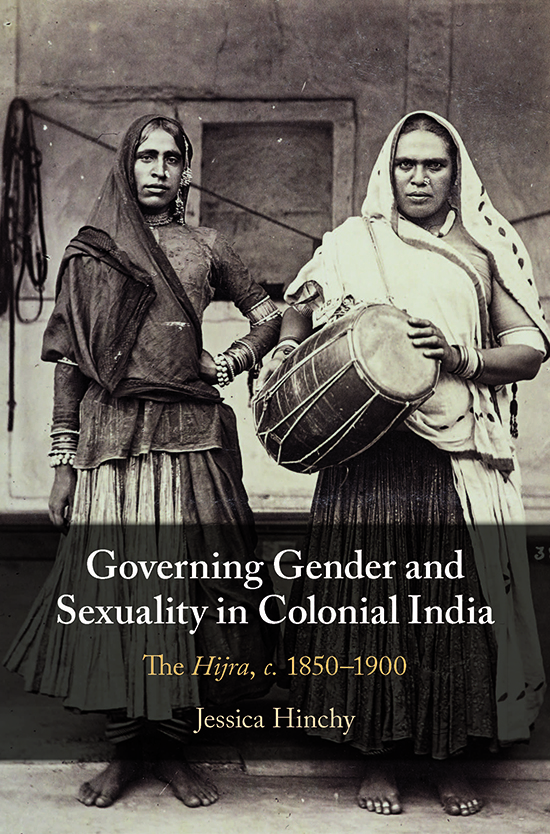At once distant and familiar, the experiences of the Hijra – a community of third gender teachers and disciples centred in northern India – intersected with the complexities and vicissitudes of British colonial rule in innumerable ways. In her groundbreaking book, Jessica Hinchy explores the multifaceted ways British imperialism sought conformity and legibility among pre-colonial Indian gender dynamics. Her analysis reveals how the quest for imperial control inexorably entailed control over gender norms, as well as how persistent that impulse remains in our world today.

On the 17th of August 1852, a Hijra named Bhoorah was found dead with her ‘head nearly severed’ in the north Indian district of Mainpuri. In the aftermath of Bhoorah’s violent death, the British rulers of north India resolved that the Hijra community should be rendered extinct. Hijras like Bhoorah performed and asked for badhai (a ‘congratulatory gift’) following the births of children, at marriages and in public spaces. They embodied a feminine gender identity, for instance through women’s clothing, and described themselves to colonial officials as having been either castrated or ‘born that way’. Hijras were initiated into discipleship lineages that linked generations of gurus (teachers) and chelas (disciples).
Bhoorah had attained guru status and had two disciples, Dullah and Mathee, with whom she lived. For two years, Bhoorah had also lived with her male lover, Ali Buksh, but shortly before she was murdered, Bhoorah had left him for another man. On the 17th of August, Ali Buksh forced Bhoorah to return to him. Neighbours saw the couple arguing in the street before entering their house. Later, Bhoorah’s disciple Dullah ran out into the street, shouting that Ali Buksh had murdered Bhoorah. In the subsequent murder trial, there were two suspects, Ali Buksh and Dullah, but the British judges were convinced that Ali Buksh had killed Bhoorah due to the ‘severance’ of their ‘infamous connexion’.
Although a Hijra was the victim of the crime under trial, the judges criminalised Hijras as cross-dressers, ‘beggars’ and ‘unnatural prostitutes’. One judge called Hijras an ‘opprobrium’ upon colonial rule, while another claimed that the continued existence of the Hijra community was a ‘reproach’ to the British government. Bhoorah’s death sparked an anxious discussion in the official circles of the province in which she lived, the North-Western Provinces (NWP). British administrators claimed that Hijras – or ‘eunuchs’ in colonial parlance – were ‘habitual sodomites’, beggars, an obscene presence in public space and the kidnappers and castrators of children. In 1865, the NWP declared that its aim was to ‘reduce’ the number of ‘eunuchs’ and thus ‘gradually lead to their extinction’. The province launched an anti-‘eunuch’ campaign that had the explicit goal of ‘extirpating’ or ‘exterminating’ the Hijra community.
For many colonial officials, Hijras were not only a danger to ‘public morals’, but also a threat to colonial political authority. The colonial government thus viewed the policing of Hijras as an ‘important branch’ of the ‘duties’ of ‘district officers’ and a priority in local policing. In the second half of the nineteenth century, Part II of the CTA received a greater level of attention at the upper echelons of government than did section 377 of the 1860 Indian Penal Code (IPC), which prohibited forms of non-reproductive sex defined as ‘unnatural’ intercourse until 2018. To many high-ranking colonial officials, the small Hijra community endangered the imperial enterprise and colonial authority. If we are to understand colonial sexual regimes in India – indeed, colonial governance in general – it is important to explore why this was so. The colonial Hijra archive also gives unusually detailed insights into the impacts of colonial law on colonised peoples who were marginalised because of their gender expression, sexual practices and intimate lives.
The colonial policing of the Hijra community throws into sharp relief the gendered character of colonial criminal law. The large body of research on the regulation of the ‘criminal tribes’ under the CTA is one place we might expect to find analysis of the colonial criminalisation of the Hijra. Yet historians of the CTA have not considered why ‘eunuchs’ and ‘criminal tribes’ were policed under the same law. When they have mentioned Part II of the CTA, they have generally relegated it to the footnotes. While there is fascinating gender analysis in the work of Padma Anagol, Satadru Sen and Clare Anderson, among others, such historians of criminal law and penal systems have largely explored gender issues in two specific contexts: first, the construction of female criminality in the policing of infanticide; and second, the gendered organisation of penal colonies and Indian jails. In fact, few historians have considered the role that gender played in the policing of the ‘criminal tribes’. There is still much we don’t know about the broader gender structures of colonial criminal law in India. This book sheds new light on the colonial governance of gender and sexuality by examining a provincial project. The focus in the broader literature has been on forms of sexual regulation that were implemented across multiple colonies, particularly the policing of prostitution and venereal disease under the Contagious Diseases Acts (CDAs) that was enacted from the 1850s. Though such trans-imperial projects are historically significant, this focus risks ignoring localised experiments in regulating sexual acts and norms, which can deepen our knowledge of the relationship between imperialism and sexuality. Regional and local histories like the anti-Hijra campaign help to answer the question of why colonial administrators viewed sexual ‘immorality’ as a problem in some contexts, but not in others. Provincial schemes show the variety of agendas that could intersect with the policing of morality. Moreover, local projects demonstrate that the techniques and knowledge that underpinned colonial gender and sexual regulation shifted between different contexts. Even as ideas of sexual deviance and criminality circulated in imperial net- works, experiments in shaping gender and sexual norms emerged from the margins of the Empire.
The text reproduced above has been condensed and has omitted historiographic citations. They can be found in the original volume.
 Jessica Hinchy is Assistant Professor in History at Nanyang Technological University, Singapore. Her main research interests are in the history of gender, sexuality, households and family in colonial north India. Her first monograph, Governing Gender and Sexuality in Colonial India: The Hijra, c. 1850-1900, was published in 2019. She can be found on social media as @HinchyJessica.
Jessica Hinchy is Assistant Professor in History at Nanyang Technological University, Singapore. Her main research interests are in the history of gender, sexuality, households and family in colonial north India. Her first monograph, Governing Gender and Sexuality in Colonial India: The Hijra, c. 1850-1900, was published in 2019. She can be found on social media as @HinchyJessica.

NOTCHES: (re)marks on the history of sexuality is licensed under a Creative Commons Attribution-NonCommercial-NoDerivatives 4.0 International License.
Based on a work at www.notchesblog.com.
For permission to publish any NOTCHES post in whole or in part please contact the editors at NotchesBlog@gmail.com




